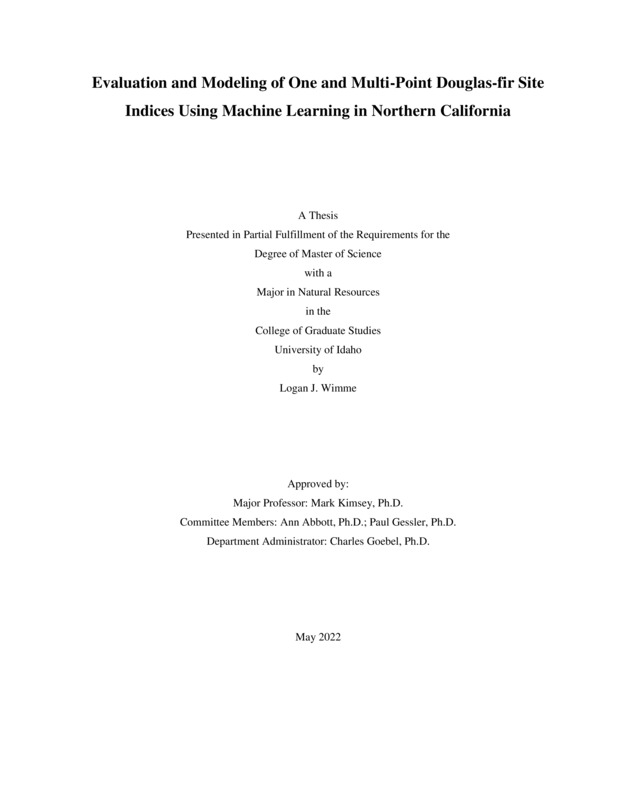Evaluation and Modeling of One and Multi-Point Douglas-fir Site Indices Using Machine Learning in Northern California
Wimme, Logan. (2022-05). Evaluation and Modeling of One and Multi-Point Douglas-fir Site Indices Using Machine Learning in Northern California. Theses and Dissertations Collection, University of Idaho Library Digital Collections. https://www.lib.uidaho.edu/digital/etd/items/wimme_idaho_0089n_12381.html
- Title:
- Evaluation and Modeling of One and Multi-Point Douglas-fir Site Indices Using Machine Learning in Northern California
- Author:
- Wimme, Logan
- Date:
- 2022-05
- Keywords:
- 10-Meter Site Index Douglas-fir Machine Learning Site Index XGBoost
- Program:
- Forest, Rangeland & Fire Sci
- Subject Category:
- Forestry
- Abstract:
-
Accurately quantifying forest productivity is a vital endeavor for modern forest managers. In north central California, one-point site index equations created from stem analysis data currently serve as the most reliable means to estimate forest productivity. Although generally sufficient, current models may inherently introduce error by failing to acknowledge how site conditions differentially impact growth rates and that growth rates fluctuate as trees mature. Therefore, alternative approaches that implicitly incorporate site growth factors may be necessary to quantify the true productive potential of forested landscapes in this region.We selected 162 Douglas-fir (Pseudotsuga menziesii (Mirb.) Franco var. menziesii) trees for destructive sampling via segmented stem analysis from a replicated orthogonal sampling matrix of known environmental growth factors. Predicted growth rates for stem segments were calculated using a locally established traditional one-point Douglas-fir site index equation that utilizes breast-height age and total height. These predicted growth rates were then compared to observed growth rates obtained using a two-point site index approach (i.e., age by log segment length). Results indicated no significant differences between observed and predicted growth rates for breast-height to 20 and breast-height to 30 m segments. However, significant underpredictions were identified for a majority of segments between breast-height and 30 m. Results suggest the effectiveness and utility of one and two-point site index approaches is highly dependent on past management practices (available site trees), future silvicultural objectives (short vs long-term rotation lengths), and a need to accurately predict temporal growth rates (carbon accumulation). To meet the demand for more reliable one and multi-point productivity estimates, extreme gradient boosting (XGBoost) machine learning models using climatic, edaphic, and topographic predictors were tested to evaluate prediction accuracies of Krumland and Eng (2005) site index and 10-meter site index (10MSI) – two site index approaches commonly used to calibrate regional growth and yield models. Multiple XGBoost models were created and compared for each site index method. The lowest 10-fold cross-validated RMSE value was used to select final models for each site index method. Final machine learning models were used to generate 0.4-hectare resolution raster layers of productivity for the study area.
- Description:
- masters, M.S., Forest, Rangeland & Fire Sci -- University of Idaho - College of Graduate Studies, 2022-05
- Major Professor:
- Kimsey, Mark; Goebel, Charles
- Committee:
- Abbott, Ann; Gessler, Paul
- Defense Date:
- 2022-05
- Identifier:
- Wimme_idaho_0089N_12381
- Type:
- Text
- Format Original:
- Format:
- application/pdf
- Rights:
- In Copyright - Educational Use Permitted. For more information, please contact University of Idaho Library Special Collections and Archives Department at libspec@uidaho.edu.
- Standardized Rights:
- http://rightsstatements.org/vocab/InC-EDU/1.0/

